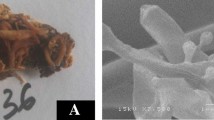Abstract
In this study, basidiomycete isolates that possessed a strong ability to degrade chromated copper arsenate (CCA)-treated wood were characterized. These fungal isolates, which were collected from CCA-treated pine log wastes, showed no recognizable morphological properties on culture media. Nucleotide sequence analysis of the large subunit rDNA of the isolates revealed that they were one species. Based on the high sequence similarity (>95%) and close phylogenetic relationship with several known species of Crustoderma, the fungal isolates characterized in this study were classified as a Crustoderma sp. In a wood degradation test, Crustoderma isolate KUC8611 produced a remarkably higher weight loss in CCA-treated Pinus radiata (68.7%), Pseudotsuga menziesii (39.7%), and Tsuga heterophylla (38.5%) wood than other evaluated basidiomycete species, including Crustoderma flavescens and Crustoderma corneum. In addition, extracellular enzymes for cellulose and protein degradation were detected when the isolates were cultured in chromogenic media, which supports the finding that isolate KUC8611 is a wood degrader. Furthermore, an in vitro test for metal tolerance revealed that isolate KUC8611 showed strong arsenic tolerance, but that it could not tolerate copper. Finally, isolate KUC8611 produced lower amounts of oxalic acid than copper-tolerant fungi such as Fomitopsis palustris and Antrodia vaillantii. To the best of our knowledge, this is the first study to report the degradation of CCA-treated wood by a Crustoderma species.

Similar content being viewed by others
References
Altschul SF, Boguski MS, Gish W, Wootton JC (1994) Issues in searching molecular sequence databases. Nat Genet 6:119–129. doi:10.1038/ng0294-119
Choi Y-S, Kim J-J, Kim G-H (2007) Diversity of indigenous microorganisms in CCA-treated wood and their ability to remediate the treated wood. Paper presented at the annual meeting of the Korean society of wood science and technology, Cheonam University, Yeosu, 19–20 April 2007
Choi Y-S, Kim J-J, Kim M-J, Kim D-H, Oh S-M, Kim G-H (2008) Metal removal of CCA-treated wood using wood vinegar. Paper presented at the annual meeting of the Korean society of wood science and technology, Gyeongsang National University, **ju, 17–18 April 2008
Clausen CA (2000) CCA removal from treated wood using a dual remediation process. Waste Manag Res 18:485–488. doi:10.1034/j.1399-3070.2000.00151.x
Clausen CA (2004) Improving the two-step remediation process for CCA-treated wood: part II. Evaluating bacterial nutrient sources. Waste Manag 24:407–411. doi:10.1016/j.wasman.2003.11.007
Clausen CA, Green FIII (2003) Oxalic acid overproduction by copper-tolerant brown-rot basidiomycetes on southern yellow pine treated with copper-based preservatives. Int Biodeterior Biodegradation 51:139–144. doi:10.1016/S0964-8305(02)00098-7
Clausen CA, Green FIII, Woodward BM, Evans JW, De Groot RC (2000) Correlation between oxalic acid production and copper tolerance in Wolfiporia cocos. Int Biodeterior Biodegradation 46:69–76. doi:10.1016/S0964-8305(00)00044-5
Collet O (1992) Comparative tolerance of the brown-rot fungus Antrodia vaillantii (DC.: Fr.) Ryv. Isolates to copper. Holzforsch 46:293–298
Curling SF, Clausen CA, Winandy JE (2002) Experimental method to quantify progressive stages of decay of wood by basidiomycete fungi. Int Biodeterior Biodegradation 49:13–19. doi:10.1016/S0964-8305(01)00101-9
Davidson RW, Campbell WA, Blaisdell DJ (1938) Differentiation of wood-decaying fungi by their reactions on gallic or tannic acid medium. J Agric Res 57:683–695
De Groot RC, Woodward B (1999) Using copper-tolerant fungi to biodegrade wood treated with copper-based preservatives. Int Biodeterior Biodegradation 44:17–27. doi:10.1016/S0964-8305(99)00047-5
Eaton RA, Hale MDC (1993) Wood-decay pests and protection. Chapman and Hall, London
Ginns J, Lefebvre MNL (1993) Lignicolous corticioid fungi of North America. Systematics, distribution and ecology. Mycol Mem 19:1–127
Green FIII, Clausen CA (2003) Copper tolerance of brown-rot fungi: time course of oxalic acid production. Int Biodeterior Biodegradation 51:145–149. doi:10.1016/S0964-8305(02)00099-9
Green FIII, Clausen CA (2005) Copper tolerance of brown-rot fungi: oxalic acid production in southern pine treated with arsenic-free preservatives. Int Biodeterior Biodegradation 56:75–79. doi:10.1016/j.ibiod.2005.04.003
Hastrup ACS, Jensen B, Clausen CA, Green FIII (2006) The effect of CaCl2 on growth rate, wood decay and oxalic acid accumulation in Serpula lacrymans and related brown-rot fungi. Holzforsch 60:339–345. doi:10.1515/HF.2006.054
Humar M, Bučar B, Pohleven F (2006) Brown-rot decay of copper-impregnated wood. Int Biodeterior Biodegradation 58:9–14. doi:10.1016/j.ibiod.2006.03.003
Illman BL, Highley TL (1996) Fungal degradation of wood treated with metal-based preservatives: 1. Fungal tolerance. The International Research Group on Wood Preservation Doc. No. IRG/WP/96–10163
Illman BL, Yang VW, Ferge L (2000) Bioprocessing preservative-treated waste wood. The International Research Group on Wood Preservation Doc. No. IRG/WP/00–50145
Kartal SN, Kakitani T, Imamura Y (2004) Bioremediation of CCA-C treated wood by Aspergillus niger fermentation. Holz Roh Werkst 62:64–68. doi:10.1007/s00107-003-0445-y
Kim J-J, Lim YW, Wingfield MJ, Breuil C, Kim G-H (2004) Leptographium bistatum sp nov., a new species with a Sporothrix synanamorph from Pinus radiata in Korea. Mycol Res 108:699–706. doi:10.1017/S0953756204000036
Kim G-H, Lim YW, Song Y-S, Kim J-J (2005) Decay fungi from playground wood products in service using LSU rDNA sequence analysis. Holzforsch 59:459–466. doi:10.1515/HF.2005.076
Lim YW, Kim J-J, Chedgy R, Morris PI, Breuil C (2005) Fungal diversity from western redcedar fences and their resistance to β-thujaplicin. Ant Leeuw 87:109–117. doi:10.1007/s10482-004-1729-x
Sierra-Alvarez R (2007) Fungal bioleaching of metals in preservative-treated wood. Process Biochem 42:798–804. doi:10.1016/j.procbio.2007.01.019
Swofford DL (2002) PAUP: Phylogenetic analysis using parsimony. Version 4.0b10. Sinauer Associates Inc., Sunderland
Thompson JD, Gibson TJ, Plewniak F, Jeanmougin F, Higgins DG (1997) The Clustal X windows interface: flexible strategies for multiple sequence alignment aided by quality analysis tools. Nucleic Acids Res 24:4876–4882. doi:10.1093/nar/25.24.4876
Yoon JH, Park JE, Suh DY, Hong SB, Ko SJ, Kim SH (2007) Comparison of dyes for easy detection of extracellular cellulases in fungi. Mycobiol 35:21–24
Acknowledgments
This work was supported by the KTOL grant funded by The National Instituted of Biological Resources, Korean Government.
Author information
Authors and Affiliations
Corresponding author
Rights and permissions
About this article
Cite this article
Choi, YS., Kim, GH., Lim, Y.W. et al. Characterization of a strong CCA-treated wood degrader, unknown Crustoderma species. Antonie van Leeuwenhoek 95, 285–293 (2009). https://doi.org/10.1007/s10482-009-9311-1
Received:
Accepted:
Published:
Issue Date:
DOI: https://doi.org/10.1007/s10482-009-9311-1




